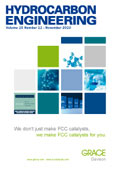Editorial comment
Over the past 100 years, the refining industry gradually developed from an industry based on simple distillation, a physical separation method, to an industry relying on catalytic technology, such as FCC, hydroprocessing, and reforming, as the core of the modern refinery. In this time the total light oil yield of a refinery increased continuously from 30 to 40% obtained by means of thermal cracking in the 1920s to 70 to 80% by catalytic conversion, and the energy efficiency improved greatly.
Register for free »
Get started now for absolutely FREE, no credit card required.
Over the past 100 years, the refining industry gradually developed from an industry based on simple distillation, a physical separation method, to an industry relying on catalytic technology, such as FCC, hydroprocessing, and reforming, as the core of the modern refinery. In this time the total light oil yield of a refinery increased continuously from 30 to 40% obtained by means of thermal cracking in the 1920s to 70 to 80% by catalytic conversion, and the energy efficiency improved greatly.

